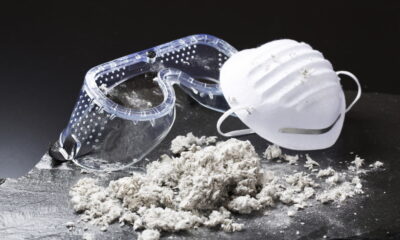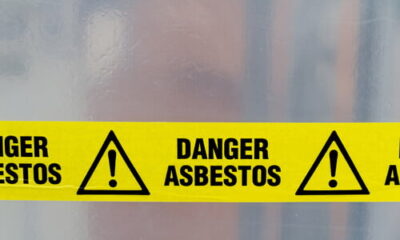

Editors Choice
The Highest Concentration Of Asbestos Sites Ranked By State
With asbestos making features in various facets of recent news we previously explored how this threat from decades past is still taking lives today. Without question, it is easy to understand the threat asbestos presents to our families and communities. September 26th marks Mesothelioma Awareness Day, established in 2004 by Meso Foundation community members, with initiatives to drive advocacy and attention to this rare cancer.
Many American employees, across a variety of industries, were exposed to asbestos on the job. Since asbestos is a fiber, exposure will often go unknown. Exposure usually occurred at major construction sites, in shipyards, on military bases and vessels, and during construction or the updating of commercial buildings. Manufacturing facility workers are often at risk including anyone in the vicinity of boilers and insulated piping. Teachers, students, and other staff members who work in dated school buildings may be at risk of exposure to asbestos products, including ceiling and floor tiles. Second hand exposure to asbestos is an equally alarming threat, families of these workers contribute to higher numbers of overall exposure risks.
Where does asbestos exposure commonly occur?
Military Sites
Air Force bases and shipyards are responsible for many cases of asbestos exposure among military personnel. Asbestos was used both in the construction of buildings at military bases as well as in the aircrafts, war vehicles, and maritime vessels.
Commercial and Industrial Sites
Aluminum plants, brewing companies, chemical plants, oil refineries, power plants and steel mills are all locations which extensively used asbestos in the construction of the structures including the heavy equipment installed inside them. Today, occupants that have taken over these spaces have an increased level of asbestos related threats, especially if a space has not undergone proper abatement and disposal processes.
Common Sites
Frequently visited places including homes, vehicles, and schools present lesser considered risks for asbestos exposure. Various auto parts were once made from asbestos fibers due to the fire and heat resistant properties. Older car parts including brakes, clutches, and gaskets may contain traces of this hazardous toxin. Depending on the year your home was build, the chances of asbestos containing materials being used during construction can present an alarming concern for families. Asbestos is present in nearly 80 percent of houses built before 1980. At one time asbestos was a common additive to insulation, tiling, roofing, cement, siding and more. Older school buildings across the country have been seen to contain many of these same building materials.
Protecting yourself against asbestos.
The handling of asbestos must be done with great caution due to the fibrous makeup and toxic properties of this substance. It’s important to note, when asbestos is in good condition, it does not usually present any hazard. It is when asbestos-containing products become worn or damaged that asbestos poses a true danger. As fibers flake off and become airborne, anyone in the surrounding area could unknowingly inhale these fibers, leading to a later development of rare lung diseases.
Asbestos at Home
Although common applications of asbestos has essentially ended, there are many old homes that still contain harmful materials. When renovation or demolition projects take place or homeowners perform DIY projects, asbestos should never be removed or disturbed without professional consulting. A licensed asbestos abatement company should always be hired to complete these tasks, not only will they know how to identify and remove asbestos, they also have the ability to properly dispose of the material, further reducing second-hand exposure risks.
Asbestos at Work
Any workplace where employees encounter asbestos will by law have an asbestos management process in place. Similar to asbestos in the home, any asbestos concerns in the workplace should be handled by licensed professionals who are trained in the best practices for abatement, and disposal of life threatening toxins.
Asbestos in the Wild
Natural disasters can result in significant damage to homes and various other buildings. If these structures contain asbestos, the harmful particles may become airborne, displaced and then travel into the environment including our water. Those responsible for the recovery and clean up of a natural disaster are at a higher risk for unknowing exposure to asbestos and developing mesothelioma. People who return too soon to the scene of destruction put themselves at a heightened risk of exposure.
Did you know:
- About 3,000 people in the U.S. are diagnosed with mesothelioma annuall.
- Naturally occurring asbestos has been found in 45 out of California’s 58 counties.
- An average 2,500 mesothelioma-related deaths happen in the United States annually.
- In Ohio there are no known natural asbestos deposits, but there are many workplaces throughout the state known to have utilized asbestos.
- The average age at the time of a mesothelioma diagnosis is 72 for women and 75 for men.
- From 1999-2015, 2,191 Texas residents died from mesothelioma.
- Mesothelioma death rates are 2 – 4 times higher in “Rust Belt” regions and port cities.
- The highest mesothelioma death rates occur in the metropolitan areas of Pennsylvania.
- Around 80% of mesothelioma cases can be attributed to exposure to asbestos.
- It’s estimated that around 20 million people in the U.S. are at risk of experiencing mesothelioma.
Statistics will only bring light to but never depict the true devastation that mesothelioma has on patients and their loved ones. This deadly cancer impacts thousands of people every year, both in the United States and in countries across the globe.
Explore the visual below to see where your home state ranks. To learn more about asbestos exposure by state including diagnosis, treatments, and survival stories head over to the Mesothelioma Cancer Alliance.

































